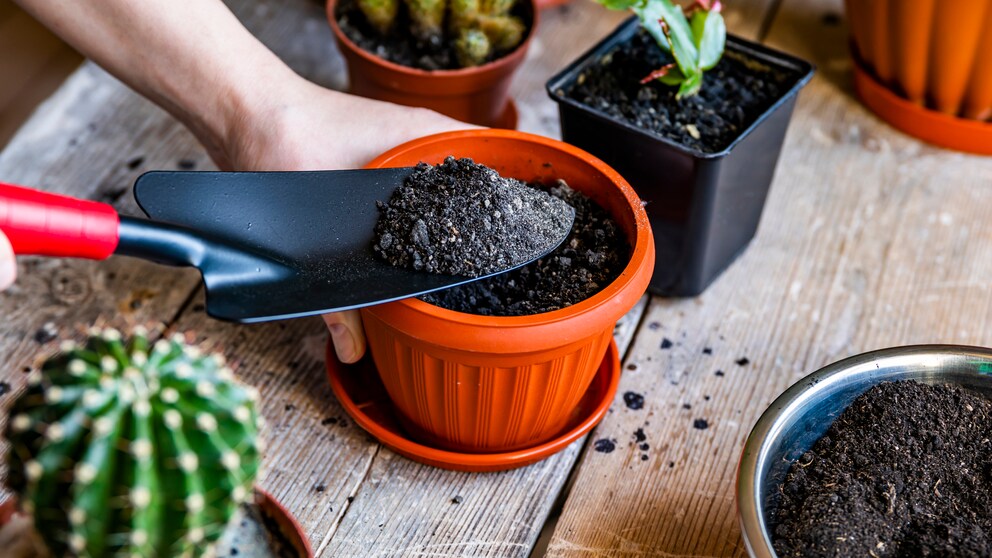May 9, 2025, 11:51 am | Read time: 4 minutes
In hardware stores or garden centers, there are often entire sections dedicated solely to soil. Alongside regular potting soil, a variety of specialized soils are available. But which soil do I need for what purpose? myHOMEBOOK provides an overview.
Is potting soil only suitable for flowering plants and garden soil only for the garden? Not quite. But why are there so many different specialty soils, and what distinguishes the various types? Well, just as each plant has different requirements for location and water, the same applies to the substrate in which it grows. myHOMEBOOK gives an overview of the different kinds of specialty soil.
Overview
Why Do Plants Need Specialty Soil?
Just by looking at different habitats, it quickly becomes clear: A cactus has different requirements for ideal growing conditions than an orchid. While cacti grow in sandy, nutrient-poor, and dry soils, orchids need substrates that retain a lot of moisture and are airy. An orchid would quickly perish in cactus soil.
This is where specialty soils come into play for home use. Their composition and structure are ideally suited to the needs of the plants for which they are offered. But what specialty soils are available?
An Overview of the Different Specialty Soils
Tomato and Vegetable Soil
- Suitable for: Tomatoes, zucchini, peppers, and cucumbers
- pH value: Slightly acidic
- Characteristics: Often very nutrient-rich, as the vegetables suitable for this specialty soil are heavy feeders. This promotes good growth.
Raised Bed Soil
- Suitable for: Herbs and vegetables in raised beds
- pH value: Slightly acidic to neutral
- Characteristics: For improved aeration and drainage in raised beds, raised bed soil is often mixed with sand, peat, and compost. The latter also increases the nutrient content.
Cactus Soil
- Suitable for: Succulents, cacti, and aloe vera
- pH value: Slightly acidic to neutral
- Characteristics: High sand or lava granulate content for good water permeability. Cacti and succulents are prone to root rot in waterlogged conditions. The nutrient content of cactus soil is comparatively low.
Citrus Soil
- Suitable for: Lemon, mandarin, and orange trees
- pH value: Slightly acidic to acidic
- Characteristics: Citrus soil is often mixed with some sand or clay to make the substrate more permeable. This creates optimal conditions in pots for Mediterranean plants.
Hydrangea Soil
- Suitable for: All types of hydrangeas
- pH value: Acidic
- Characteristics: High peat and humus content to increase water retention capacity. Additionally, the lime content is low. Combined with aluminum added to some hydrangea soils, this supports the blue coloration in blue-flowering varieties.
Seed and Propagation Soil
- Suitable for: Seeds and cuttings
- pH value: Slightly acidic to neutral
- Characteristics: A low nutrient content ensures even growth of seedlings. Additionally, propagation soil has good water retention due to its fine structure.
Rhododendron Soil
- Suitable for: Rhododendrons, azaleas, blueberries, and hydrangeas
- pH value: Very acidic
- Characteristics: High humus content and loose structure. Plants sensitive to lime are well-suited with acidic rhododendron soil.
Orchid Soil
- Suitable for: Orchids like Phalaenopsis and Cattleya
- pH value: Slightly acidic to neutral
- Characteristics: Coarse structure with bark pieces, coconut chips, or expanded clay, all of which absorb a lot of moisture and are very air-permeable. Additionally, the nutrient content is low.

Which Houseplants Can Be Fertilized with Coffee Grounds

Fertilize hydrangeas correctly for long and lush flowering

Planting and Care Tips for the Spitting Palm as a Houseplant
Can You Mix Specialty Soil Yourself?
When faced with the sometimes expensive specialty soils at the hardware store, one might quickly ask: Is this really necessary? Unfortunately, yes, because without the right substrate, tomatoes and the like will only grow weakly, and cacti will quickly perish. However, with some skill, some specialty soils can be mixed yourself.
For propagation soil, for example, one-third of garden soil must be mixed with one-third of mature compost and one-third of coarse sand. Cactus soil, on the other hand, is a bit more demanding. For this, 50 percent potting soil must be mixed with 20 percent fine sand (preferably quartz sand), 15 percent pumice, and 15 percent expanded clay in a bucket. So, if you don’t have all the individual components for specialty soil at home and want to ensure the substrate’s composition is optimal, it’s best to opt for the ready-made mix.

